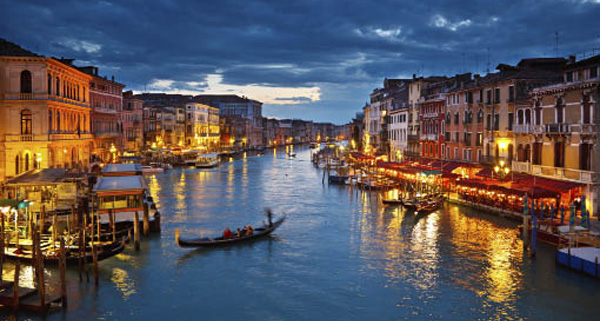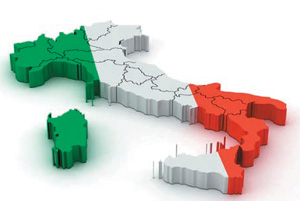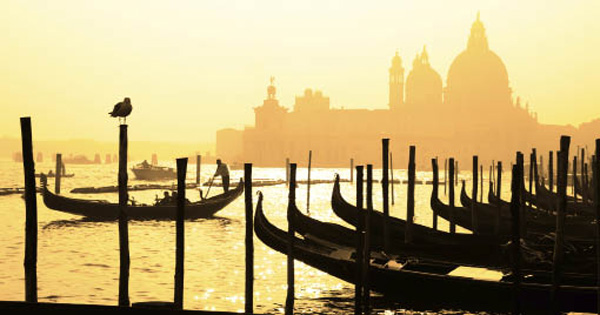Once touted as the “Land of air conditioning” by a local manufacturers’ organisation, Italy is presently going through economically challenging times.
Once touted as the “Land of air conditioning” by a local manufacturers’ organisation, Italy is presently going through economically challenging times. Numbers showing unprecedented growth and expansion are now continuously dwindling, with no signs of recovery anytime soon. Despite the depressing scenario or, perhaps, because of it, Italian HVACR companies are on their toes and are not sleeping on the job. Jerome Sanchez has the report.

The economic crisis that struck Europe in the latter part of 2008 has definitely affected the Italian HVACR industry. The turn of events could not have been more drastic. In 2007, the Italian Association of Manufacturers of Air Conditioning and Ventilation Equipment Co. AER (Associazione construttori di apparecchiature ed impianti aeraulici) reported that the air conditioning and refrigeration market in Italy had strong sales growth to show – with 13.4% more air conditioning units sold and 22.2% more turnover achieved compared to 2006. In 2012, however, the same association revealed that, in the first nine months of 2012, the HVACR industry had a negative turnover and that the longer and hotter summer experienced in the country did not help the cause of the industry. It reported declines across different sectors of the industry, including multi-split, mono-split, VRF, mini VRF, centralised units, fan coils, and refrigerants.
“Sales of the HVACR industry in 2012 were lower than in 2011,” says Stefano Berton, Senior Manager, Product Marketing, Air Conditioning and Industrial, Eliwell. “We can estimate an average decline of 12% for the internal market.” He cites a survey conducted by the Italian Federation of Mechanical and Engineering Industries ANIMA (Federazione delle associazioni nazionali dell’industria meccanica varia ed affine) for Co. AER which showed that in 2012, the number of installations for rooftop air conditioners and fan coils dropped by 15%, while installations for air handling units and multi-splits registered a decline of 20%. “Better was the market for single split units and movable units with a performance [at par] with the previous year,” adds Berton.
Michele Paccagnella, Managing Director, MP3 Srl, paints the same dismal picture when he says that the general outlook of the HVACR industry in Italy is still bleak and the forecast is that the market will be further reduced by 20% in the coming years.
Marco Galluppi, Manager, South Europe and Middle East, Carel Industries, confirms the above observations and says that the difficult economic situation and the recent elections have caused a significant decline in government procurement.
Not all is doom and gloom, however. According to a report in the ASHRAE Journal published in May 2012, titled “In Italy, Business Goes On”, many companies reported a rise in demand from foreign markets, where 1.5% growth was projected for 2012. The same report adds that the number of foreign visitors at the Mostra Convergno Expocomfort, a biennial HVACR trade fair that is one of Europe’s most important industry events, increased by four per cent – an indication that the Italian companies are shifting their focus to exports during the sustained economic slump.
Mitigating the decline
 Italian HVACR companies have adopted different strategies to thrive through the economic slack, including increasing investments in R&D, introducing new products and reaching out to different countries for business.
Italian HVACR companies have adopted different strategies to thrive through the economic slack, including increasing investments in R&D, introducing new products and reaching out to different countries for business.
“Despite the crisis, we have never taken off resources and investments from our research and development department,” says Berton, “because our industry is based on innovation and technology and we believe that it represents the real future of the company.” He adds that in these economically trying times, his company considers product innovation, manufacturing automation and globalisation as key factors that can drive growth.
Adds Berton: “We do not expect big improvements in a short time for the Italian or for the Southern European markets. Our strategy is to expand in countries where the trend is better, like in Germany, Eastern Europe, Turkey, the Middle East and Africa.” He says that Eliwell intends to expand its presence in the afore-mentioned markets through local investments and through providing better technical support. “We want to follow our customers not only through the seller but also by bringing technical support close to them,” explains Berton. He also reveals that Eliwell has created a regional sales and technical support team in China, where it has started production of some components exclusively for the Asian market.
Galluppi shares the information that in addition to investing in product innovation and in HVAC consultants and designers, and to focusing on high-efficiency solutions and energy savings, Carel is continuously expanding its operations in the BRICS (Brazil, Russia, India, China and South Africa) countries and in the Middle East.
Paccagnella endorses the view that investing heavily in R&D is one of the main strategies of MP3 to survive in the aftermath of the downturn. “Investing on R&D allowed us to enter new and smaller niche market, with an increase in revenue of four per cent to five per cent in the domestic market and more than 20% in exports,” he says. In terms of exports, Paccagnella says that MP3 is expanding its presence in Northern European countries like Holland, Denmark and Finland.
Mauro Montello, Sales and Marketing Manager, Climaveneta, shares the information that to combat the crisis, his company is entering into new sales channels and offering integrated project solutions. In addition, he says that Climaveneta is aiming to directly target tenants and investors to make them aware of sustainability and efficiency. Speaking about his company’s export strategy, Montello says, “We are now entering the South American market and strengthening our position in China and India with local production plants.”
Hitting the target
In light of the economic downturn and the rising cost of energy in Italy, there has been a heightened and intensified focus on energy efficiency. In addition, the EU heads of state and governments have set a series of demanding climate and energy targets to be met by 2020, known as the “20-20-20” targets. In summary, these are:
Commenting on how Climaveneta responds to the call for higher energy efficiency among HVACR products, Montello says: “Climaveneta has always invested in energy-efficiency solutions development in order to provide in each building and in every season a high level of comfort and low energy consumption.” He further claims that the use of inverter solutions, the possibility of combining its products with renewable resources and the drive for developing more efficient components allow Climaveneta to deliver high-efficiency solutions to its customers.
He reveals that his company has begun installing multi-purpose units capable of heating, cooling and producing sanitary hot water at the same time. “Providing a single solution to both needs (heating and cooling), the unit makes use of the synergies between heating and cooling, ensuring much higher energy efficiency than traditional systems, which are based on separate chillers and boilers,” he explains.
Speaking for Eliwell, Berton says: “The new standards and regulations related to energy conservation, environmental protection and the use of natural refrigerants have led us to innovate our controllers and stimulate our technical office to create new ideas.” He adds that his company’s products are being developed to address the need to optimise energy usage and meet the regulations set forth. “We have also focused strongly on simplifying the installation of our products, the ease of use and the accessibility of informative reports to aid the energy costs control initiatives,” he adds.
Galluppi, highlighting how Carel contributes to meeting the “20-20-20” targets, says: “It is interesting to underline that the European Union has officially recognised heat pumps as renewable energy sources, only as regards the part of heat taken from the environment, and taking into consideration the electricity consumption when the heat pump is powered electrically.” In addition, he reveals that the European Heat Pump Association (EHPA), which Carel is a member of, regularly takes part in EU initiatives to promote knowledge of heat pump and development of heat pump technology for residential, commercial and industrial applications in the European market by providing legislators technical and economic support, including that in relation to energy efficiency.
“Following significant economic investments in R&D,” adds Galluppi, “Carel is able to offer the market the highest performance solutions for maximum energy efficiency of heat pumps, guaranteeing highest seasonal performance.”
In the context of reducing greenhouse gas emissions, Galluppi reveals that Carel is continuously cooperating with partners and customers to develop new environmentally friendly solutions. “We have developed – and are continuing to develop – numerous applications based on CO2, both transcritical and subcritical, in several countries around the world,” he says. He adds that the use of CO2 minimises the sources of direct pollution (refrigerant leaks) and indirect pollution (electricity consumption) by guaranteeing good energy efficiency in specific system solutions.

Eye on the Middle East
There is no denying that Europe, including Italy, has been badly hit by the economic recession. With the industry continuously being plagued by negative turnovers year after year, have the Italian industry players considered shifting their commercial attention to the Middle East, which is seen to be less affected by the crisis?
Montello discusses his company’s view of the Middle East: “The harsh climate conditions typical of the Middle East make energy efficiency and extended operating limits even more crucial factors for an effective air conditioning solution.” He claims that Climaveneta has products suited for the Middle East that feature extremely low running costs, leading to the reduction of the total lifecycle cost. “This is achieved thanks to an extreme focus on the quality of components and on their optimal integration, which steered all the technological decisions at the engineering stage,” he says.
Galluppi shares his observation that there is presently more emphasis on choosing the most appropriate energy-saving technology in the Middle East, taking into account the local climate characteristics and the local market specifics. “The most effective energy-efficiency technologies,” he explains, “are evaporative cooling and local and remote monitoring/telemaintenance systems.” He points out that the above-mentioned technologies can guarantee constant, high-performance monitoring of installations, allowing the operating conditions to be adapted to the actual demand.
Eliwell, which already has a strong presence in the Middle East, continues to see the region as an important gateway to Africa and other countries: “This makes the region more attractive. For sure we will invest to further increase our presence in the Middle East,” says Berton, speaking for his company.
Paccagnella, on the other hand, says that MP3 has also worked on tenders for projects in the Middle East, including in Qatar and Saudi Arabia, but only got a lukewarm reception from the market. “We found out that these countries are still far from acknowledging and choosing new technologies,” he says, and adds, “like other markets in the Middle East, their choice is still based on the price offered, resulting in more economic but less efficient solutions.”
Conclusion
Italian HVACR industry players are unanimous in saying that the recession has heavily hit the country’s economy and that the dark clouds of the downturn have yet to pass. With negative numbers and dismal outlook looming large, the industry players are bracing themselves for what may be the worst that is yet to come. New strategies and fresh approaches to business have been put in place to keep the Italian HVACR companies afloat: more investment in R&D, heightened focus on after-sales service and a more aggressive approach towards exportation. Despite the depressing situation, the Italian industry players are keeping their hopes up and are staying vigilant to new market trends that could arise from the present situation.
Copyright © 2006-2025 - CPI Industry. All rights reserved.